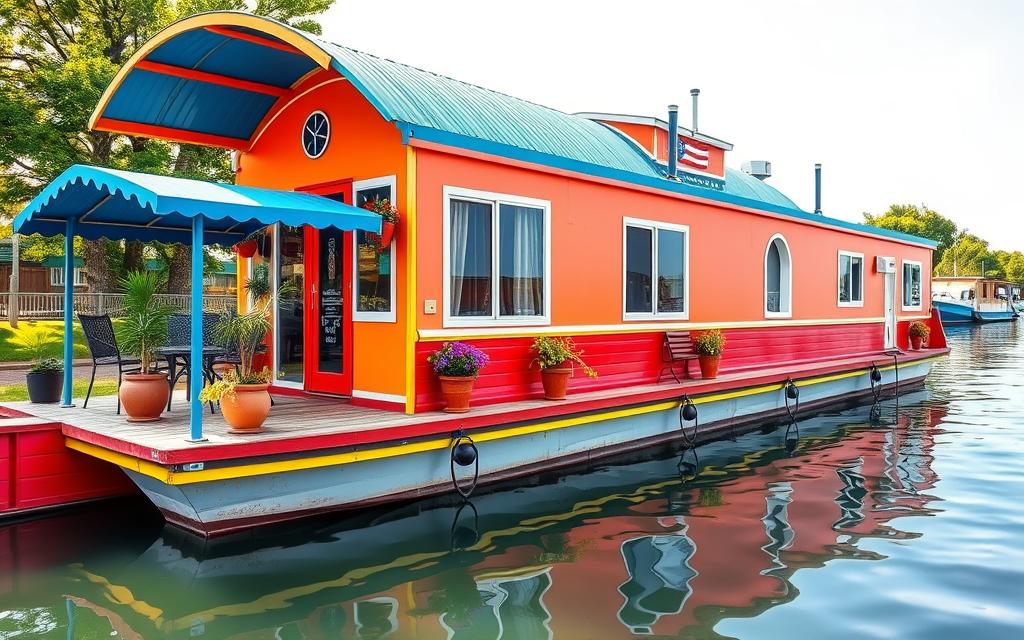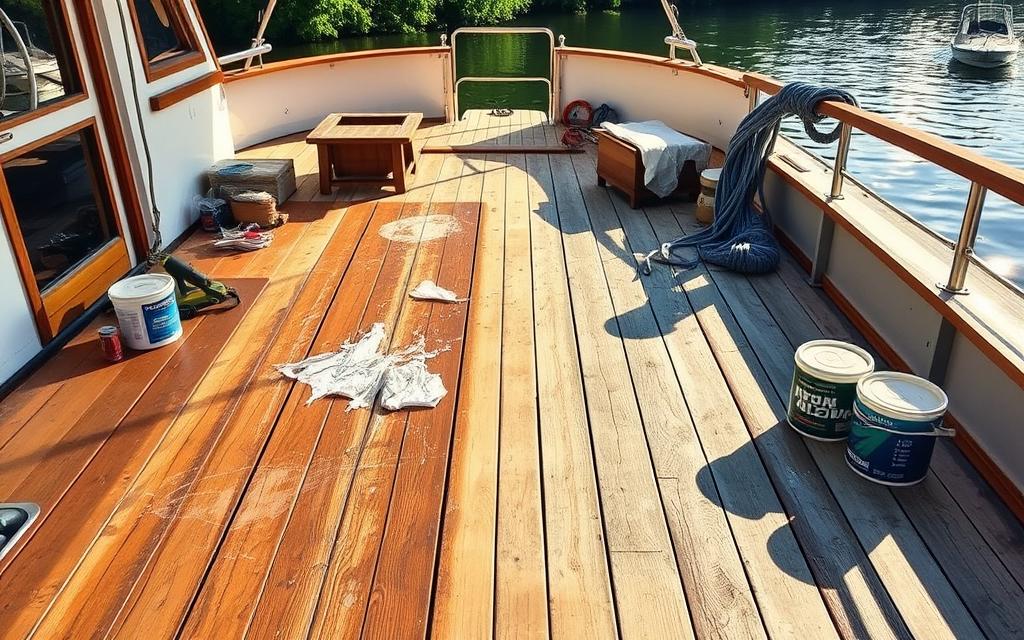Table of Contents
As a proud houseboat owner, I know how vital it is to keep your boat’s exterior in top shape. Painting and refurbishing your houseboat’s exterior is key to keeping its value high and making it look great on the water. In this guide, I’ll share my knowledge on choosing the right materials, techniques, and maintenance plans. This will help your houseboat look its best.

Key Takeaways
- Understand the importance of using marine-grade materials for your houseboat’s exterior
- Learn essential surface preparation techniques to ensure a flawless finish
- Discover the best painting and refurbishing methods to protect your investment
- Explore anti-fouling solutions and waterproof coatings to keep your houseboat in pristine condition
- Develop a regular maintenance schedule to preserve the beauty of your houseboat’s exterior
Understanding Marine-Grade Materials and Essential Tools
When painting your houseboat’s exterior, picking the right materials and tools is key. These products are made to handle the tough marine environment. They keep your boat’s look and protection strong for many years.
Types of Marine-Grade Paints and Coatings
Marine-grade paints fight off sun, salt, and water damage. They have special pigments and binders for better adhesion and color. You can choose from epoxy, polyurethane, and silicone-based coatings, each with its own benefits.
Required Tools and Safety Equipment
- High-quality paint rollers and brushes for marine use
- Orbital sander or palm sander for prep
- Degreasing agents and cleaning supplies
- Protective gear like respirators, goggles, and gloves
Environmental Considerations for Paint Selection
Think about the paint’s environmental impact too. Choose marine-grade paints that are environmentally friendly. Look for low VOC or water-based options. They’re good for the ocean and safer for you.
“Choosing the right boat painting techniques and materials can make all the difference in the longevity and appearance of your houseboat’s exterior.”
SHORTCODE FOR NEWSLETTER:-
Initial Assessment and Project Planning for Houseboat Restoration
Starting a houseboat restoration project needs careful planning and a detailed look at your boat’s current state. As someone who loves DIY, I know how key this first step is. It ensures your project is both successful and affordable.
First, you must do a full check-up of your houseboat. Look at the outside, inside, and any mechanical or electrical parts that need fixing. Note any repairs, refinishing, or replacements needed. This helps you make a detailed plan and budget.
- Check the hull, deck, and superstructure for wear, damage, or decay.
- Look at windows, doors, and weatherstripping for leaks or drafts.
- Make sure the electrical and plumbing systems work well.
- Check if the boat’s appliances, fixtures, and furniture are working right.
After understanding what needs fixing, it’s time to make a project plan. This plan should have a timeline, a budget, and a list of materials and tools. Breaking the project into smaller tasks helps you stay organized and on track.
| Restoration Task | Estimated Cost | Timeline |
|---|---|---|
| Hull Repair and Painting | $2,500 – $4,000 | 2-3 weeks |
| Deck Refinishing | $1,000 – $2,000 | 1-2 weeks |
| Window Replacement | $800 – $1,500 | 1 week |
| Electrical System Upgrade | $1,500 – $3,000 | 2-3 weeks |
By carefully checking your houseboat and making a detailed plan, you’re set for a successful houseboat restoration. This will give you many years of fun on the water.
Surface Preparation Techniques for Boat Exterior
Getting your boat’s surfaces ready is key for a paint job that lasts. We’ll look at cleaning, degreasing, sanding, and fixing oxidation and corrosion on your houseboat’s outside.
Cleaning and Degreasing Methods
Begin by cleaning the boat well to get rid of dirt, grease, and other stuff that might stop paint from sticking. Use a mild soap and a hard-bristled brush to scrub off grime.
Then, use degreasing solvents to tackle tough oils and dirt. Make sure to rinse everything off and let it dry before you do anything else.
Sanding and Smoothing Procedures
Now, sand the boat’s outside to make it smooth for painting. Start with rough sandpaper to take off old paint or rough spots. Then, switch to finer grits for a perfect finish. Make sure to pay extra attention to edges and corners for an even texture.
Dealing with Oxidation and Corrosion
- For oxidation spots, use a special boat oxidation remover to make the surface shine again.
- To fix corrosion, sand off the bad spots and apply a primer that stops rust before painting.
- It’s very important to fix these problems well, as they can harm the boat’s structure and the paint job.
By using these prepping boat surfaces, boat oxidation removal, and surface preparation techniques, you’ll get a finish that’s smooth, strong, and will last for years. Your houseboat will look great for a long time.
Painting and Refurbishing Your Houseboat’s Exterior
Painting and refinishing your houseboat’s exterior is key to keeping it looking good and protected. Whether you want to refresh an old boat or give a new one a makeover, it’s a detailed process. We’ll cover the essential steps for a perfect houseboat painting job.
First, preparing the surface is critical. You need to clean and sand it well to get a smooth base for painting. This step removes old damage and ensures the new paint sticks well. With the right steps, you can make your houseboat look brand new again.
For the houseboat painting itself, there are different boat refinishing techniques to choose from. You might use rollers, spray painting, or both, depending on the material and finish you want. Picking the right exterior boat coatings is also important for lasting results.
It’s important to focus on tricky spots like corners and designs. Using the right tools and methods will help you get a smooth finish. This finish will protect your houseboat’s exterior for many years.
“The key to a successful houseboat painting project is attention to detail and a commitment to quality workmanship.”
Remember, good surface prep, quality marine-grade paints, and careful application are key. With these steps, you can make your houseboat look great and stay protected for years.

Anti-fouling Protection and Waterproof Coatings
Keeping your houseboat’s exterior in good shape is key for its long life and best performance. Two important things to think about are anti-fouling protection and waterproof coatings. Anti-fouling paints stop marine growth like algae and barnacles from sticking to the hull. They create a barrier that keeps these organisms away, keeping your houseboat’s bottom clean and efficient.
Bottom Paint Application
Applying anti-fouling bottom paint right is vital for good protection. First, clean and prepare the surface well. Then, apply the paint as the maker says. How often you need to reapply depends on the paint type and where your houseboat is.
Waterproofing Techniques
Waterproof coatings are also key for keeping your houseboat’s exterior in check. They stop water from getting in and protect what’s underneath. There are many waterproofing methods, like deck paints and sealants for seams. They help keep your houseboat dry and safe.
Protection Against Marine Growth
There are ways to protect your houseboat from marine growth too. Regular hull cleaning and using fenders and bumpers can help. These steps, along with waterproof coatings and anti-fouling paints, offer strong protection for your houseboat’s outside.
Understanding the role of anti-fouling protection and waterproof coatings is important. It helps keep your houseboat’s exterior in great shape. This protects its performance and keeps its value high for many years.
Deck Restoration and Non-Slip Coating Application
Keeping your houseboat’s deck safe and looking good is key. If your deck is old or you want it to be safer, restoring it can make a big difference. This process can give your deck a fresh new look.
Choosing the right materials and applying them carefully is the secret to boat deck restoration. Use marine-grade paints and coatings made for decks. They last long, protect against the weather, and keep your deck safe for everyone.
Fixing any damage on your deck is a big part of the restoration. This might mean filling cracks, fixing loose boards, or dealing with oxidation or corrosion. Preparing the surface well is important for applying new deck coatings.
After fixing your deck, think about adding slip-resistant surfaces. Use non-slip deck coatings like special marine paints or textured epoxy. They make your deck safer, look good, and prevent slips and falls.

Applying boat deck restoration and non-slip coatings right is important. Follow the instructions from the manufacturer for even coverage and a smooth finish. With the right steps, your houseboat’s deck will be safe, durable, and beautiful.
Hull Maintenance and Protective Measures
Keeping your houseboat’s hull in good shape is key to its long life and performance. It protects against the elements and stops marine growth. A well-maintained hull makes a big difference in your vessel’s life. Let’s look at the main parts of hull care and how to keep your houseboat in great shape.
Hull Coating Systems
The base of hull care is the coating system you pick. Marine-grade hull coatings fight off the tough marine world. They protect against water, UV rays, and other dangers. When choosing a coating, think about adhesion, how well it holds up, and anti-fouling to keep your houseboat safe.
Impact Protection Solutions
Protecting your houseboat’s hull from damage is vital. Impact protection solutions like special fenders or bumpers help. They absorb the shock of docking or accidents, keeping the hull safe. These measures help avoid expensive fixes and keep your houseboat looking good longer.
Regular Maintenance Schedule
Having a regular maintenance schedule is essential for your houseboat’s hull. This includes checks, cleaning, touch-ups, and new coatings. Being proactive with maintenance stops damage and keeps your houseboat in top shape for years.
“A well-maintained hull not only enhances the appearance of your houseboat but also contributes to its overall performance and longevity.”
Conclusion
In this guide, we’ve covered the key steps for painting and refurbishing your houseboat’s exterior. You now know about marine-grade materials and tools. You also know how to prepare the surface for painting.
Keeping your houseboat in good shape is important. Use marine-grade paints and coatings to protect it. Also, install anti-fouling protection and maintain the hull and deck regularly. This way, your boat will stay beautiful and safe for a long time.
Now, it’s time to use your diy boat refurbishing skills. With the right tools and materials, you can make your houseboat look new again. You can turn it into a place that shows off your style and taste.
FAQ
What types of marine-grade paints and coatings should I use for my houseboat’s exterior?
For your houseboat’s exterior, choose high-quality marine-grade paints and coatings. Look for epoxy-based paints and polyurethane topcoats.
Also, pick specialized anti-fouling paints for the hull. These products offer weatherproofing, UV resistance, and protection against saltwater and marine growth.
What safety precautions should I take when preparing and painting my houseboat?
Safety is key when painting your houseboat. Wear gloves, goggles, and a respirator when sanding and applying paints.
Make sure the area is well-ventilated and follow all safety instructions. Also, use eco-friendly products to protect the environment.
How do I properly prepare the surface of my houseboat for painting?
Proper surface preparation is essential for a great paint job. Clean and degrease the exterior, removing dirt and old coatings. Sand the surfaces to make them smooth and even. This ensures the paint sticks well and looks good.
What are the best techniques for applying paint and coatings to my houseboat’s exterior?
The right painting technique is important. Use high-quality brushes, rollers, or airless spray equipment for even application.
Focus on edges and corners, and apply thin coats for the best look. Follow the manufacturer’s drying and recoat instructions for success.
How can I protect my houseboat’s hull and deck from damage and marine growth?
Protect your houseboat’s hull and deck with anti-fouling paints and waterproof coatings. Anti-fouling paints prevent marine growth. Use waterproof sealants and non-slip coatings for extra protection. Regular maintenance keeps your houseboat in great shape.
How often should I maintain and refinish my houseboat’s exterior?
Maintenance and refinishing frequency depends on climate, usage, and paint quality. Inspect your houseboat’s exterior yearly and fix any issues. Repaint or reapply coatings every 3-5 years to keep it looking good and protected.



